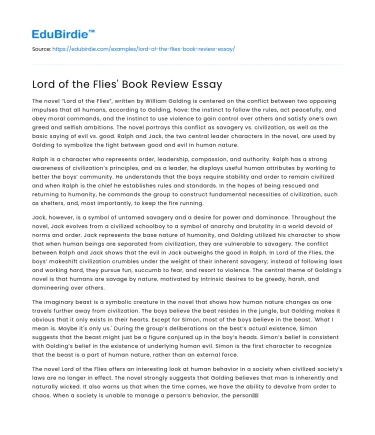The novel “Lord of the Flies”, written by William Golding is centered on the conflict between two opposing impulses that all humans, according to Golding, have: the instinct to follow the rules, act peacefully, and obey moral commands, and the instinct to use violence to gain control over others and satisfy one’s own greed and selfish ambitions. The novel portrays this conflict as savagery vs. civilization, as well as the basic saying of evil vs. good. Ralph and Jack, the two central leader characters in the novel, are used by Golding to symbolize the fight between good and evil in human nature.
Ralph is a character who represents order, leadership, compassion, and authority. Ralph has a strong awareness of civilization’s principles, and as a leader, he displays useful human attributes by working to better the boys’ community. He understands that the boys require stability and order to remain civilized and when Ralph is the chief he establishes rules and standards. In the hopes of being rescued and returning to humanity, he commands the group to construct fundamental necessities of civilization, such as shelters, and, most importantly, to keep the fire running.
Save your time!
We can take care of your essay
- Proper editing and formatting
- Free revision, title page, and bibliography
- Flexible prices and money-back guarantee
Jack, however, is a symbol of untamed savagery and a desire for power and dominance. Throughout the novel, Jack evolves from a civilized schoolboy to a symbol of anarchy and brutality in a world devoid of norms and order. Jack represents the base nature of humanity, and Golding utilized his character to show that when human beings are separated from civilization, they are vulnerable to savagery. The conflict between Ralph and Jack shows that the evil in Jack outweighs the good in Ralph. In Lord of the Flies, the boys’ makeshift civilization crumbles under the weight of their inherent savagery; instead of following laws and working hard, they pursue fun, succumb to fear, and resort to violence. The central theme of Golding’s novel is that humans are savage by nature, motivated by intrinsic desires to be greedy, harsh, and domineering over others.
The imaginary beast is a symbolic creature in the novel that shows how human nature changes as one travels further away from civilization. The boys believe the beat resides in the jungle, but Golding makes it obvious that it only exists in their hearts. Except for Simon, most of the boys believe in the beast. 'What I mean is. Maybe it's only us.' During the group’s deliberations on the best’s actual existence, Simon suggests that the beast might just be a figure conjured up in the boy’s heads. Simon’s belief is consistent with Golding’s belief in the existence of underlying human evil. Simon is the first character to recognize that the beast is a part of human nature, rather than an external force.
The novel Lord of the Flies offers an interesting look at human behavior in a society when civilized society’s laws are no longer in effect. The novel strongly suggests that Golding believes that man is inherently and naturally wicked. It also warns us that when the time comes, we have the ability to devolve from order to chaos. When a society is unable to manage a person’s behavior, the person’s sense of cruelty intensifies, leading to brutality and violence. Golding’s depiction of the dark side of human nature looks to be highly realistic, as one human’s act of violence against another is witnessed on a daily basis, whether on a tiny individual scale or in a large-scale worldwide conflict. The moral of Golding’s story is clear: a civilized society influenced by the impacts of governance and order, both are which are absent in Lord of the Flies, is humans’ best hope for recognizing and managing the monster within them. If not, despite laws attempting to maintain order, humans are greedy for power and dominance.






 Stuck on your essay?
Stuck on your essay?

